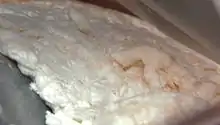2C-T-2
2C-T-2 is a psychedelic and entactogenic phenethylamine of the 2C family. It was first synthesized in 1981 by Alexander Shulgin, and rated by him as one of the "magical half-dozen" most important psychedelic phenethylamine compounds.[1][2] The drug has structural and pharmacodynamic properties similar to those of 2C-T-7 ("Blue Mystic").
 | |
 | |
 | |
| Names | |
|---|---|
| IUPAC name
2-[4-(Ethylsulfanyl)-2,5-dimethoxyphenyl]ethan-1-amine | |
| Identifiers | |
3D model (JSmol) |
|
| ChEMBL | |
| ChemSpider | |
| ECHA InfoCard | 100.241.509 |
PubChem CID |
|
| UNII | |
CompTox Dashboard (EPA) |
|
| |
| |
| Properties | |
| C12H19NO2S | |
| Molar mass | 241.35 g/mol |
| Hazards | |
| GHS pictograms |  |
| GHS Signal word | Warning |
| H302 | |
| P264, P270, P301+312, P330, P501 | |
Except where otherwise noted, data are given for materials in their standard state (at 25 °C [77 °F], 100 kPa). | |
| Infobox references | |
Dosage
In Alexander Shulgin's book PiHKAL, the dosage range is listed as 12 to 25 mg.[2]
Pharmacology
The mechanism of action that produces 2C-T-2’s hallucinogenic and entheogenic effects has not been specifically established, however it is most likely to result from action as a 5-HT2A serotonin receptor agonist in the brain, a mechanism of action shared by all of the hallucinogenic tryptamines and phenethylamines for which the mechanism of action is known.
Dangers
There are no known reports of neurotoxicity, but very little scientific knowledge exists for 2C-T-2. All confirmed fatalities involving 2C-T drugs involve high doses taken by the nasal route or dangerous combinations with stimulant and depressant drugs such as alcohol, MDMA, and cocaine.
Drug prohibition laws
Canada
As of October 31, 2016, 2C-T-2 is a controlled substance (Schedule III) in Canada.[4]
China
As of October 2015 2C-T-2 is a controlled substance in China.[5]
Netherlands
The Netherlands became the first country in the world to ban 2C-T-2, and classify it as a hard drug, by law. In April, 1999, 2C-T-2 became a list I drug of the Opium Law.
Sweden
Schedule I in Sweden.
2C-T-2 was first classified as "health hazard" under the act Lagen om förbud mot vissa hälsofarliga varor (translated Act on the Prohibition of Certain Goods Dangerous to Health) as of April 1, 1999, under SFS 1999:58[6] that made it illegal to sell or possess.
The Riksdag added 2C-T-2 to Narcotic Drugs Punishments Act under Swedish schedule I ("substances, plant materials and fungi which normally do not have medical use") as of March 16, 2004, published by Medical Products Agency (MPA) in regulation LVFS 2004:3 listed as 2C-T-2, 2,5-dimetoxi-4-etyltiofenetylamin.[7]
United Kingdom
2C-T-2 and all other compounds featured in PiHKAL are illegal drugs in the United Kingdom.
United States
2C-T-2 is specifically listed as a schedule I substance under SEC. 1152 of S.3187: Food and Drug Administration Safety and Innovation Act of 2012.
Australia
2C-T-2 is considered a Schedule 9 prohibited substance in Australia under the Poisons Standard (October 2015).[8] A Schedule 9 substance is a substance which may be abused or misused, the manufacture, possession, sale or use of which should be prohibited by law except when required for medical or scientific research, or for analytical, teaching or training purposes with approval of Commonwealth and/or State or Territory Health Authorities.[8]
References
- Theobald, DS; R Staack; M Puetz; HH Mauer (September 2005). "New designer drug 2,5-dimethoxy-4-ethylthio-β-phenethylamine (2C-T-2): studies on its metabolism and toxicological detection in rat urine using gas chromatography/mass spectrometry". Journal of Mass Spectrometry. 40 (9): 1157–1172. doi:10.1002/jms.890. PMID 16041763.
- "Erowid Online Books : "PIHKAL" - #40 2C-T-2". www.erowid.org.
- Last Argentina Controlled Drugs List
- Gazette, Government of Canada, Public Works and Government Services Canada, Public Services and Procurement Canada, Integrated Services Branch, Canada. "Canada Gazette – Regulations Amending the Food and Drug Regulations (Part J — 2C-phenethylamines)". gazette.gc.ca.
- "关于印发《非药用类麻醉药品和精神药品列管办法》的通知" (in Chinese). China Food and Drug Administration. 27 September 2015. Archived from the original on 1 October 2015. Retrieved 1 October 2015.
- "Förordning (1999:58) om förbud mot vissa hälsofarliga varor". www.notisum.se.
- "Läkemedelsverkets författningssamling" (PDF) (in Swedish). lakemedelsverket.se.
- Poisons Standard October 2015 https://www.comlaw.gov.au/Details/F2015L01534